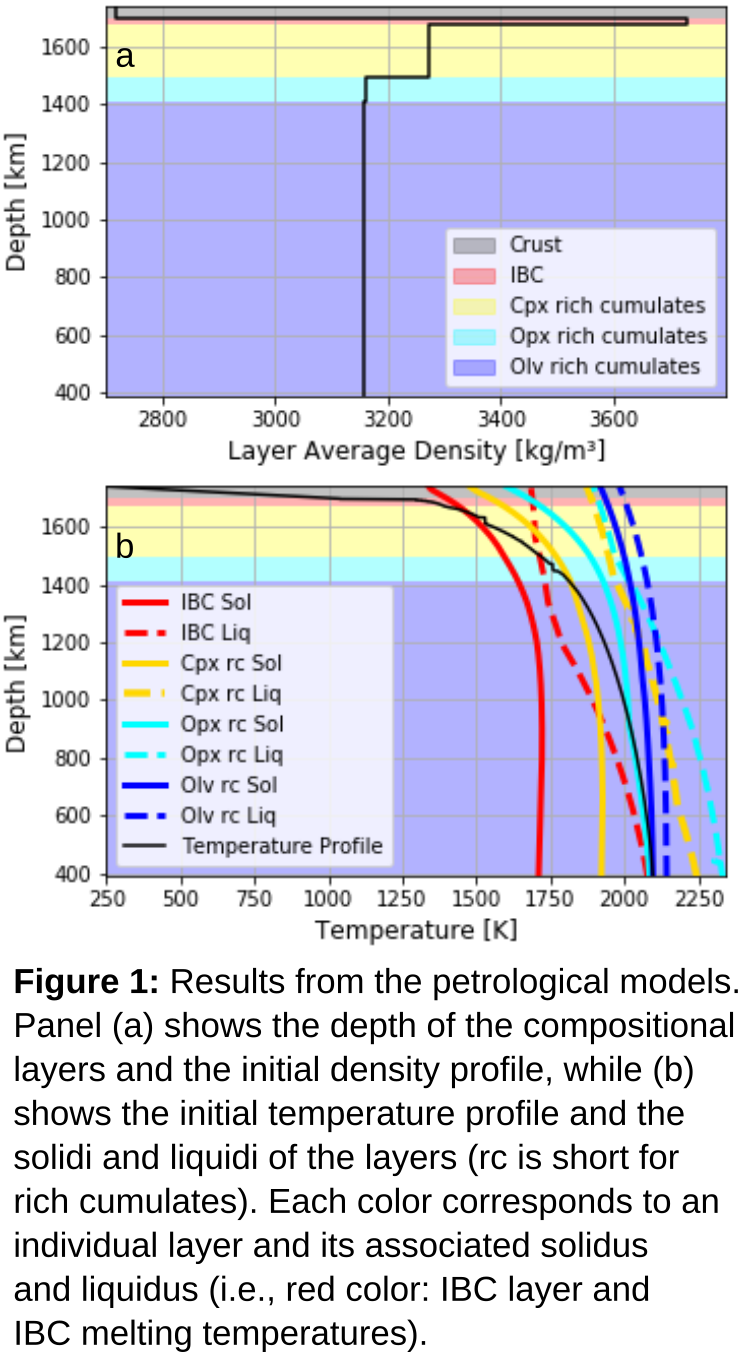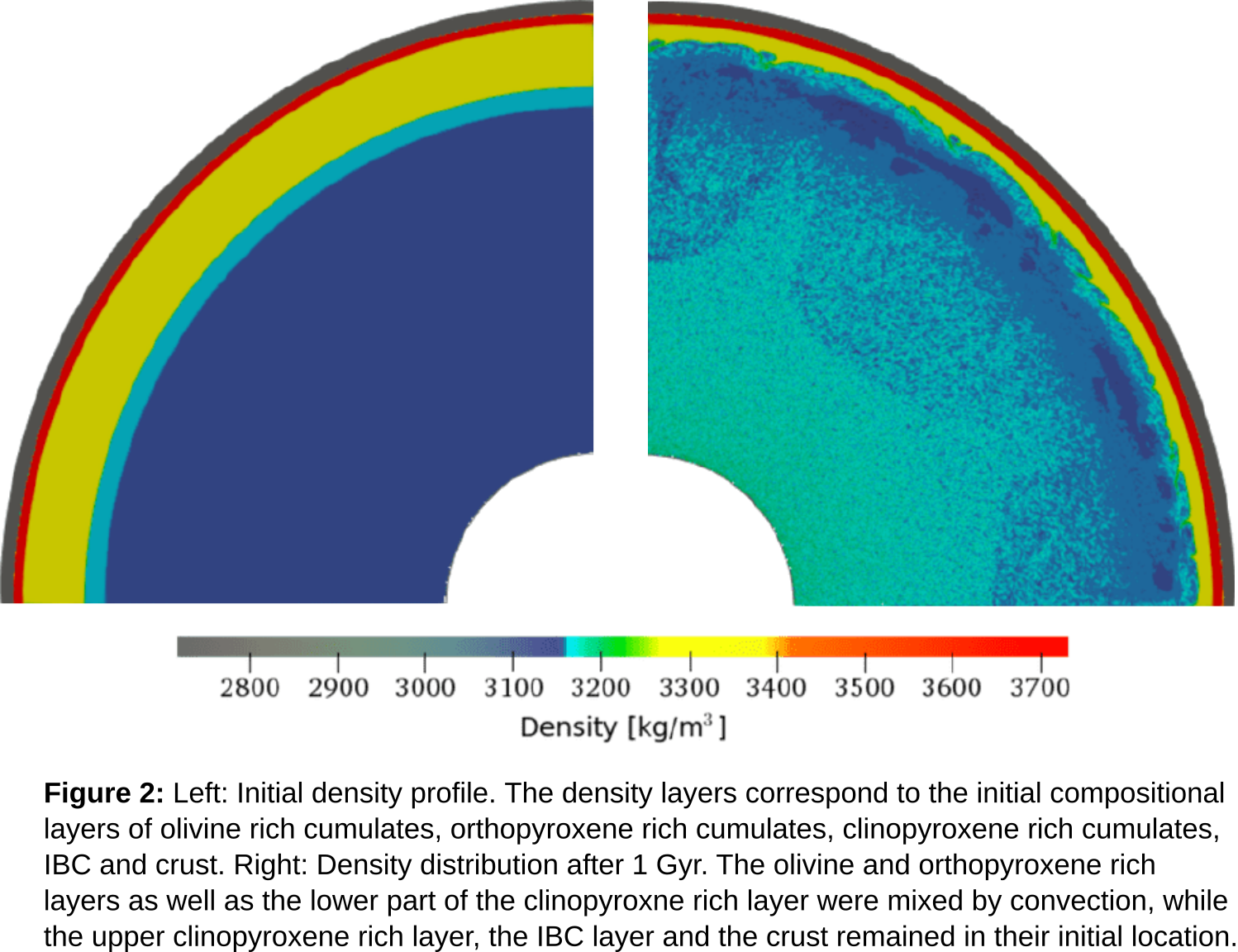Convection and melting in a heterogenous lunar mantle
- German Aerospace Center (DLR), Institute of Planetary Research
Introduction
During the early stages of lunar evolution, the large amount of heat available from the lunar forming impact led to extensive melting of the Moon’s silicate mantle giving rise to a magma ocean. The fractional crystallization of the latter resulted in an inhomogeneous mantle with cumulate layers of increasing density towards the surface, due to iron enrichment in the residual magma ocean [1]. Such an unstable density distribution is prone to overturn and sets the stage for the subsequent thermo-chemical history of the mantle. In particular, this initial stage can significantly affect mixing of mantle material and the partial melt production, as well as the melt composition during the later stages of lunar evolution. The melt composition is directly linked to the composition of lunar basalts, whose variability at the lunar surface indicates complex melting processes and the presence of various mantle reservoirs.
In this study we model the solid-state convection, mixing and partial melt production in the lunar mantle. We investigate the effects of an initially layered mantle as a consequence of the fractional crystallization of the lunar magma ocean. To this end, we combine geodynamical models using the mantle convection code GAIA with petrological calculations that provide information about the composition and structure at the end of lunar magma ocean (LMO) solidification.
While previous mantle convection studies investigated lunar mantle melting in a purely homogeneous mantle [2] or with a localized KREEP layer [3,4], here we combine petrological and geodynamical models to investigate the degree of heterogeneity that can be produced by melting and mixing an initially heterogeneous lunar mantle.
Petrological modeling
The petrological model computes the crystallization sequence of the LMO. For the calculations in the deeper part of the mantle we use FOXMTR, for the shallower part alphaMELTS, as this approach is in good agreement with experimental data for the whole solidification process. We assume fractional crystallization of a spherical shell with an initial thickness of 1350 km, and a bulk lunar mantle composition from [5].
During crystallization the temperature is lowered stepwise and all minerals (except plagioclase) are assumed to accumulate at the bottom of the LMO and equilibrate with the melt at the respective pressure conditions. Plagioclase is assumed to float to the surface and form anothoritic crust.
The resulting mantle structure is characterized by 5 compositional layers, where the predominant minerals are olivine, orthopyroxene, clinopyroxene, clinopyroxene and ilmenite (ilmenite bearing cumulates = IBC) and plagioclase (crust), respectively. For each of those layers an average density is calculated from the density profile after crystallization, as well as the change in density as a function of depletion. The solidus and liquidus temperature profiles are calculated for the average layer compositions using alphaMELTS.
The depths and densities of the compositional layers, the initial temperature profile, the solidus and liquidus profiles for each layer and the density-depletion functions of each layer composition are provided in the form of read-out tables.
The results from the petrological model are shown in figure 1. The densities of the mantle layers increase with radius due to the enrichment of iron in the melt during crystallization. The crust has a comparative low density (figure 1a).
The temperature profile follows the crystallization temperatures of the cumulates. In figure 1b the temperature profile is shown together with the individual layers and their corresponding solidi and liquidi. From olivine to IBC the solidus and liquidus temperatures decrease because of the crystallization sequence (figure 1b).

Geodynamical modelling
We use the mantle convection code GAIA [6] in a 2D quarter cylinder geometry to model the thermochemical evolution of the compositionally heterogeneous lunar mantle. The nondimensional conservation equations of mass, momentum, thermal energy, and composition are solved under the extended Boussinesq approximation. We use an Arrhenius law to calculate the temperature- and depth-dependent viscosity.
To track the composition of the mantle we use a particle-in-cell (PIC) method [7], where tracer particles carry information about material properties such as density, melting temperature, degree of depletion, amount of heat producing elements etc. Our models use between 35 to 50 particles per cell that are advected at each time step according to the velocity field.
In our simulations we account for core cooling and radioactive decay, as well as mechanical mixing. In addition, we consider the effects of melting by accounting for the latent heat during mantle melting, as well as solidus and density increase/decrease due to mantle depletion [8]. During melting, low melting point components are extracted from the mantle as the melt rises to the surface to form the basaltic crust. This leads to an increase of the solidus temperature requiring a higher temperature to further melt the residual mantle material. Gradual changes in density and solidus temperatures are extracted from the precomputed read-out tables of the petrological modelling.
Summary and Outlook
Our coupled petrological-geodynamical model of mantle convection and melt production will be used to investigate the thermochemical evolution of an initially heterogeneous lunar mantle structure (figure 2). Preliminary results show a smaller amount of melt produced in a heterogeneous mantle in comparison to a homogeneous one. We will present the distribution of the compositional layers as a function of time and compare the amount of melting produced from each individual component.
With this approach we aim to provide a link between melting processes in the interior of the Moon and the compositional diversity of basalts observed at the lunar surface. This in turn will help us to put constraints on the LMO crystallization and the subsequent thermochemical history of the Moon.

Acknowledgements
We thank Brian Doherty for his contribution to the numerical implementation.
I.B. and S.S. were supported by the German Research Foundation (Deutsche Forschungsgemeinschaft) SFB-TRR170, (subprojects C4 and A5).
References
[1] Elkins-Tanton et al., Annu. Rev. Earth Planet Sci. 2012; [2] Ziethe et al., PSS, 2009; [3] Laneuville et al., JGR, 2013 [4] Laneuville et al., JGR, 2018; [5] O’Neill et al., 1991; [6] Hüttig et al., PEPI, 2013; [7] Plesa et al., IGI Global, 2013; [8] Doherty et al., AGU, 2018.
How to cite: Bernt, I., Plesa, A.-C., Schwinger, S., Collinet, M., and Breuer, D.: Convection and melting in a heterogenous lunar mantle, Europlanet Science Congress 2021, online, 13–24 Sep 2021, EPSC2021-834, https://doi.org/10.5194/epsc2021-834, 2021.

